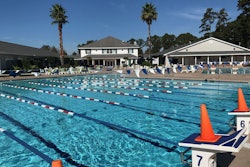SOURCE: National Athletic Trainers' Association (NATA)
DALLAS, TX – A special thematic issue of the Journal of Athletic Training, the National Athletic Trainers’ Association’s scientific publication, was recently released. The themed issue focuses on ankle sprains and instability as ankle sprains are the most common injury experienced by athletes and others who engage in physical activity. 1 Additionally, the research reveals that a large number of those who sprain their ankle also develop disorders, such as recurrent ankle sprains, chronic ankle instability and osteoarthritis. The thematic issue aims to address important clinical concerns through a series of literature reviews, clinical commentaries and original research articles that present the current state of the science of preventing, assessing and treating patients with ankle sprains and instability. 2
“We recognize that an initial acute ankle sprain can easily lead to lifelong issues that will affect health-related quality of life,” said Journal of Athletic Training Editor in Chief Jay Hertel, PhD, ATC, FNATA. “One major goal of this issue is to explore ways to prevent and address ankle sprains and chronic instability to help people lead healthier and more active lives.”
Key Statistics
Acute ankle sprains are among the most common musculoskeletal injuries with an estimated 2 million occurring each year in the United States. 3 Anecdotal perception suggests that ankle injuries are minor; however, up to 70% of individuals who sustain an acute ankle sprain may develop residual physical disability. 4 Exercise-based prevention programs can reduce the risk of ankle sprain by 28% and all ankle injuries by 47%. 5 Individuals who developed chronic ankle instability who did not seek medical treatment after their initial ankle sprain reported worse self-reported function than those who sought medical attention after their first ankle sprain. 6 Individuals who developed chronic ankle instability who did not seek medical treatment after their initial ankle sprain reported more recurrent ankle sprains since the initial injury than those who sought medical attention after their first ankle sprain. 7
Highlights from the Special Issue:
603 Epidemiology of Ankle Sprains and Chronic Ankle Instability Mackenzie M. Herzog, Zachary Y. Kerr, Stephen W. Marshall and Erik A. Wikstrom Acute ankle sprains are among the most common musculoskeletal injuries and up to 70% of individuals who sustain an acute ankle sprain may develop residual physical disability, which may include chronic ankle instability.
Acute ankle sprains occur at high rates across all levels of sports participation and among other active populations, such as active duty military personnel; however, half of all ankle sprains treated in U.S. emergency departments reportedly did not occur during sport activity.
Evidence suggests a strong link between a prior ankle sprain and an increased risk for a future ankle sprain. Continued investigation into the link between the ankle sprain incident and chronic ankle instability and the development of posttraumatic osteoarthritis is needed.
650 Prevention of Lateral Ankle Sprains Thomas W. Kaminski, Alan R. Needle and Eamonn Delahunt External prophylactic supports (ankle taping and bracing) are effective for reducing the risk of ankle sprains in both uninjured and previously injured populations. Ankle bracing appears to offer the best outcomes in terms of cost and risk reduction compared to ankle taping. Preventive exercise programs emphasizing balance and ankle strengthening are effective in reducing the risk of ankle sprains in both uninjured and previously injured populations.
671 Lack of Medical Treatment From a Medical Professional After an Ankle Sprain Tricia Hubbard-Turner The majority of participants in this study did not seek medical treatment for their initial lateral ankle sprains.
Those who did not seek medical treatment for their initial ankle sprain scored worse on the Foot and Ankle Ability Measure. Those who did not seek medical treatment for their initial ankle sprain suffered more recurrent ankle sprains. The public needs to be educated on the significance of an ankle sprain and the need for proper treatment and management to prevent long-term joint dysfunction. The full special thematic issue of ankle sprains and instability can be accessed here.
About NATA:
National Athletic Trainers’ Association (NATA) – Health Care for Life & Sport Athletic trainers are health care professionals who specialize in the prevention, diagnosis, treatment, and rehabilitation of injuries and sport-related illnesses. They prevent and treat chronic musculoskeletal injuries from sports, physical and occupational activity, and provide immediate care for acute injuries. Athletic trainers offer a continuum of care that is unparalleled in health care. The National Athletic Trainers' Association represents and supports 45,000 members of the athletic training profession. For more information, visitwww.nata.org.
1. Jay Hertel and Thomas W. Kaminski (2019) These Are the Sprains of Our Lives. . .. Journal of Athletic Training: June 2019,Vol. 54, No. 6, pp. 569-569.2. Jay Hertel and Thomas W. Kaminski (2019) These Are the Sprains of Our Lives. . .. Journal of Athletic Training: June 2019,Vol. 54, No. 6, pp. 569-569.3. Mackenzie M. Herzog, Zachary Y. Kerr, Stephen W. Marshall, and Erik A. Wikstrom (2019) Epidemiology of Ankle Sprains andChronic Ankle Instability. Journal of Athletic Training: June 2019, Vol. 54, No. 6, pp. 603-610.4. Mackenzie M. Herzog, Zachary Y. Kerr, Stephen W. Marshall, and Erik A. Wikstrom (2019) Epidemiology of Ankle Sprains andChronic Ankle Instability. Journal of Athletic Training: June 2019, Vol. 54, No. 6, pp. 603-610.5. Thomas W. Kaminski, Alan R. Needle, and Eamonn Delahunt (2019) Prevention of Lateral Ankle Sprains. Journal of AthleticTraining: June 2019, Vol. 54, No. 6, pp. 650-661.
6. Tricia Hubbard-Turner (2019) Lack of Medical Treatment From a Medical Professional After an Ankle Sprain. Journal ofAthletic Training: June 2019, Vol. 54, No. 6, pp. 671-675.7. Tricia Hubbard-Turner (2019) Lack of Medical Treatment From a Medical Professional After an Ankle Sprain. Journal ofAthletic Training: June 2019, Vol. 54, No. 6, pp. 671-675.





























